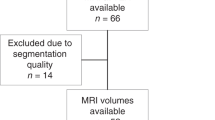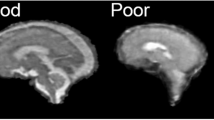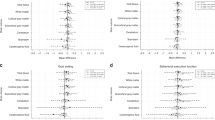Abstract
Background
Human studies investigating the link between postnatal polyunsaturated fatty acids and preterm brain growth are limited, despite emerging evidence of potential effects on outcomes.
Methods
Sixty preterm neonates <32 weeks gestational age with magnetic resonance imaging (MRI) scanning at near-birth and near-term age were assessed for brain tissue volumes, including cortical gray matter, white matter, deep gray matter, cerebellum, brainstem, and ventricular cerebrospinal fluid. Red blood cell fatty acid content was evaluated within 1 week of each MRI scan. Neurodevelopmental outcome at 30–36 months corrected age was assessed.
Results
Adjusting for potential confounders, higher near-birth docosahexaenoic acid levels are associated with larger cortical gray matter, deep gray matter, and brainstem volumes and higher near-term levels with larger deep gray matter, cerebellar, and brainstem volumes at near-term age; lower near-birth linoleic acid levels are correlated with larger white matter volume at near-term age. By 30–36 months corrected age, larger cortical and deep gray matter, cerebellar, and brainstem volumes by term age are associated with improved language scores and larger cerebellar and brainstem volumes with improved motor scores.
Conclusion
Specific polyunsaturated fatty acid levels have differential and time-dependent associations with brain region growth. Larger brain volumes are associated with improved outcomes at preschool age.
Similar content being viewed by others
Log in or create a free account to read this content
Gain free access to this article, as well as selected content from this journal and more on nature.com
or
References
Blencowe H, Cousens S, Oestergaard MZ et al. National, regional, and worldwide estimates of preterm birth rates in the year 2010 with time trends since 1990 for selected countries: a systematic analysis and implications. Lancet 2012;379:2162–2172.
de Kieviet JF, Zoetebier L, van Elburg RM et al. Brain development of very preterm and very low-birthweight children in childhood and adolescence: a meta-analysis. Dev Med Child Neurol 2012;54:313–323.
Soria-Pastor S, Padilla N, Zubiaurre-Elorza L et al. Decreased regional brain volume and cognitive impairment in preterm children at low risk. Pediatrics 2009;124:e1161–e1170.
Petrou S, Henderson J, Bracewell M et al. Pushing the boundaries of viability: The economic impact of extreme preterm birth. Early Hum Dev 2006;82:77–84.
Almaas AN, Tamnes CK, Nakstad B et al. Long-chain polyunsaturated fatty acids and cognition in VLBW infants at 8 years: an RCT. Pediatrics 2015;135:972–980.
Fleith M, Clandinin MT . Dietray PUFA for preterm and term infants: review of clinical studies. Crit Rev Food Sci Nutr 2005;45:205–229.
Lapillonne A . Enteral and parental lipid requirements of preterm infants. World Rev Nutr Diet 2014;110:82–98.
Lauterbach R . A supplementation of DHA and AA to human milk-fed VLBW infants has no significant cognitive improvement or measurable neuroanatomical effects when evaluated at 8 years of age. Evid Based Med 2015;20:177.
Wainwright PE . Dietary essential fatty acids and brain function: a developmental perspective on mechanisms. Proc Nutr Soc 2002;61:61–69.
Isaacs EB, Gadian DG, Sabatini S et al. The effect of early human diet on caudate volumes and IQ. Pediatr Res 2008;63:308–314.
Isaacs EB, Fischl BR, Quinn BT et al. Impact of breast milk on intelligence quotient, brain size, and white matter development. Pediatr Res 2010;67:357–362.
Tan M, Abernethy L, Cooke R . Improving head growth in preterm infants—a randomized controlled trial II: MRI and developmental outcomes in the first year. Arch Dis Child Fetal Neonatal Ed 2008;93:342–346.
Lind A, Parkkola R, Lehtonen L et al. Associations between regional brain volumes at term-equivalent age and development at 2 years of age in preterm children. Pediatr Radiol 2011;41:953–961.
Monson BB, Anderson PJ, Matthews LG et al. Examination of the pattern of growth of cerebral tissue volumes from hospital discharge to early childhood in very preterm infants. JAMA Pediatr 2016;170:772–779.
Skiöld B, Alexandrou G, Padilla N et al. Sex differences in outcome and associations with neonatal brain morphology in extremely preterm children. J Pediatr 2014;164:1012–1018.
Van Kooij BJ, Benders MJ, Anbeek P et al. Cerebellar volume and proton magnetic resonance spectroscopy at term, and neurodevelopment at 2 years of age in preterm infants. Dev Med Child Neurol 2012;54:260–266.
Tam EW, Chau V, Barkovich AJ et al. Early postnatal docosahexaenoic acid levels and improved preterm brain development. Pediatr Res 2016;79:723–730.
Tam EW, Miller SP, Studholme C et al. Differential effects of intraventricular haemorrhage and white matter injury on preterm cerebellar growth. J Pediatr 2011;158:366–371.
Liu M, Kitsch A, Miller SP et al. Patch-based augmentation of Expectation-Maximization for brain MRI tissue segmentation at arbitrary age after premature birth. Neuroimage 2016;127:387–408.
Innis SM, Nelson CM, Rioux MF et al. Development of visual acuity in relation to plasma erythrocyte omega-6 and omega-3 fatty acids in healthy term gestation infants. Am J Clin Nutr 1994;60:347–352.
Innis SM . Dietary (n-3) fatty acids and brain development. J Nutr 2007;137:855–859.
Martin CR, DaSilva DA, Cluette-Brown JE et al. Decreased postnatal docosahexaenoic and arachidonic acid blood levels in premature infants are associated with neonatal morbidities. J Pediatr 2011;159:743–749.
Xiao Y, Huang Y, Chen ZY . Distribution, depletion and recovery of docosahexaenoic acid are region-specific in the rat brain. Br J Nutr 2005;94:544–550.
Innis SM . Fatty acids and early human development. Early Hum Dev 2007;83:761–766.
Innis SM . Perinatal biochemistry and physiology of long-chain polyunsaturated fatty acids. J Pediatr 2003;143:S1–S8.
Birch EE, Birch DG, Hoffman DR et al. Dietary essential fatty acid supply and visual acuity development. Invest Ophthalmol Vis Sci 1992;33:3242–3253.
Elias SL, Innis SM . Infant plasma trans, n-6, and n-3 fatty acids and conjugated linoleic acids are related to maternal fatty acids, length of gestation, and birth weight and length. Am J Clin Nutr 2001;73:807–814.
Vlaardingerbroek H, Hornstra G . Essential fatty acids in erythrocyte phospholipids during pregnancy and at delivery in mothers and their neonates: comparison with plasma phospholipids. Prostaglandins Leukot Essent Fatty Acids 2004;71:363–374.
Novak EM, Ling DJ, Innis SM . Low linoleic acid may facilitate Δ6 desaturase activity and docosahexaenoic acid accretion in human fetal development. Prostaglandins Leukot Essent Fatty Acids 2012;86:93–98.
Salvati S, Attorri L, Avellino C et al. Diet, lipids and brain development. Dev Neurosci 2000;22:481–487.
Acknowledgements
We thank Sheila M. Innis, RD, PhD for her assistance with analyzing blood samples for fatty acid levels. We also thank Kenneth J. Poskitt, MD, FRCPC for his assistance in reviewing MRI scans at the University of British Columbia study site.
Stateement of Financial Support
The study was supported by the Gerber Foundation (Fremont, MI) (E.W.Y.T., D.M.F.), Canadian Institutes for Health Research (CIHR) CHI 151135 (S.P.M.), National Institutes of Health (NIH) NIH/NINDS R01 NS 061957 (C.S.), NIH/NINDS R01 NS 055064 (C.S.), NIH R01 NS346432 (A.J.B.), NIH P01NS082330 (D.M.F.), and NeuroDevNet (Vancouver, Canada) (S.P.M.). The funders had no role in study design, data collection, analysis or interpretation, decision to publish, or preparation of the manuscript.
Author information
Authors and Affiliations
Corresponding author
Ethics declarations
Competing interests
The authors declare no conflict of interest.
Rights and permissions
About this article
Cite this article
Kamino, D., Studholme, C., Liu, M. et al. Postnatal polyunsaturated fatty acids associated with larger preterm brain tissue volumes and better outcomes. Pediatr Res 83, 93–101 (2018). https://doi.org/10.1038/pr.2017.230
Received:
Accepted:
Published:
Issue date:
DOI: https://doi.org/10.1038/pr.2017.230
This article is cited by
-
Brain development using a multicomponent intravenous lipid emulsion in preterm infants
BMC Pediatrics (2024)
-
Home-ics: how experiences of the home impact biology and child neurodevelopmental outcomes
Pediatric Research (2024)
-
Maternal milk in the NICU: An everyday intervention to improve brain development
Pediatric Research (2024)
-
The influence of nutrition on white matter development in preterm infants: a scoping review
Pediatric Research (2023)
-
Serum docosahexaenoic acid levels are associated with brain volumes in extremely preterm born infants
Pediatric Research (2021)



